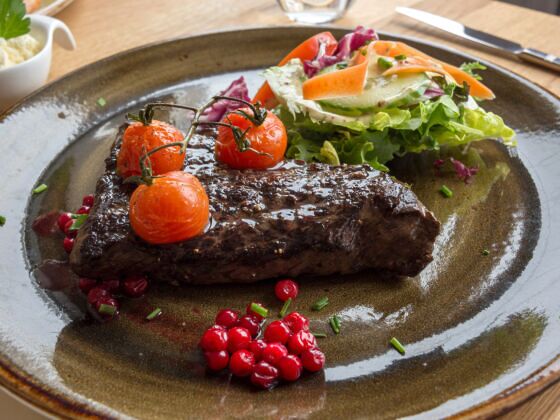With its idyllic waterfront location on the chic Aker Brygge-district of Oslo and its steel-and-glass exterior, Rorbua might not strike you as a seafood restaurant that pays tribute to Northern Norwegian cuisine. Named after the traditional seasonal huts used by sailors along the Norwegian coast, the reference becomes apparent once you take a step inside the restaurant. Here you will find big-game rifles hanging on the plank-wood walls and a steering helm at the bar. If you’re a curious eater who knows anything about Scandinavian cuisine, you’ll probably know that this is where to try whale meat in Norway.

Whale Meat Is the Controversial Dish Every Visitor to Norway Should Try at Least Once
What’s catching the attention of the foreign tourists and the locals on this early spring evening is the menu. A common conversation point along the tables is whether the guests have tried hvalbiff – or whale steak.
Across the national Norwegian restaurant scene, whale meat has seen a growth in demand the last couple of years, mostly due to an increasing interest in local cuisine and consumers growing tired of industrially produced meat such as pork and beef.
For many years, meat from minke whales has been considered a controversial ingredient in Norwegian cuisine. By the mid-20th century, many species of whale had been driven close to extinction. As a result, commercial whaling was banned worldwide in 1986. Norway remains one of only three countries to at least officially allow commercial whaling, along with Iceland and Japan. Norwegian governments have over the years cited cultural reasons for flouting the 1986 ban and maintain that the hunt is limited only to minke whales – a species not under threat from extinction. It is estimated that more than 100,000 minke whales live in the Norwegian and Barents Seas.
Last year, 575 minke whales were caught in Norway. Even though it is less than half the annual quota of 1,286, the number remains the largest increase in almost a decade. Hunting season starts in April and continues until the end of September.
Small fishing vessels, mounted with a harpoon cannon on the bow, are used to catch minke whales. Each harpoon comes loaded with explosives that go off once they have penetrated about a foot into the flesh of the whale. The internal blast is supposed to cause enough brain damage to kill or knock out the whale within a few seconds. Should the whale survive the grenade harpoon, the gunner will usually pick up a high-powered rifle to finish the job.
The whale, usually 22 feet in length and up to 5.5 tons, is hauled onto the vessel and is stripped of its blubber, gutted, and carved up for meat. Much of the catch is sent to the Japanese market, where the demand is high.
As the COVID-19 pandemic devastated the travel industry, whalers in Norway have reaped the rewards of a national staycation. Norwegians who would usually have traveled to Italy or Spain have instead headed towards domestic destinations like Lofoten Islands above the Polar Circle, a scenic destination, rich in sparkling fjords, jagged coastlines, and endless days of midnight sun. Here, the tradition of serving hvalbiff has been preserved for millennia and has spread across to the national restaurant scene. Now, for the first time in decades, demand for whale meat has outstripped supply.
Back at Rorbua, although the choice of food this evening resembles the varied menu cart, the majority of guests get a taste of whale. The meat from the tail fin of the whale is the most sought-after cut and is fried as a steak. The experience?
Whale meat is a much more gamey and tender version of beef, and quite chewy yet with the melt in the mouth texture of tuna. The taste is mild and somewhat similar to moose and reindeer, but contains higher nutritional values, including a high level of protein and is easier to digest. Here’s where to sample whale meat for yourself in Norway.
Where to eat whale meat in Norway
Bryggeloftet & Stuene: Specializing in traditional Norwegian dishes like reindeer, fish soup topped with fresh prawns, and minke whale meat, of course, Bryggeloftet is one of the oldest restaurants in Bergen. Founded in 1910, in the historical west coast city of Bergen, Bryggeloftet prides itself on offering hearty food, and using fresh catch from the North Sea. It’s known especially for its heartfelt hospitality, and if you make a reservation, expect to be greeted by restaurant owner Inger, who enjoys a personal relationship with many of the regulars.
Where: Bryggen 11, 5003 Bergen
Rorbua: Rorbua is committed to using staple ingredients of traditional Arctic circle cooking in all its dishes, especially dried seafood snacks, smoked whale meat, and unsalted stockfish. The restaurant offers a cozy atmosphere inside and a stunning view of the Oslo inner fjord, making it one of the most interesting restaurants in the Norwegian capital.
Where: Aker Brygge, Stranden 71, 0250 Oslo
Lofotmat: This little cozy restaurant is located in beautiful Henningsvær on the magnificent Lofoten Islands above the Arctic Circle. Lofotmat offers exceptional fried scallops, gratinated dry fish, duck, and whale. The restaurant sources its ingredients from local producers, including seaweed, edible plants, herbs, and fresh seafood.
Where: Dreyersgate 56, 8312 Henningsvær
Dødeladen: Dødeladen has a strong connection to the sea as the building originally served as an insurance office for local fishermen, so expect to be treated to an atmosphere that feels true to the Norwegian way of life, and an extensive list of seafood delicacies. In addition to the must-try hvalbiff, the menu features classic dishes like moules marinières, dried and salted cod, baked clams, and a local version of the Portuguese bacalao.
Where: Skippergata 1A, 6507 Kristiansund